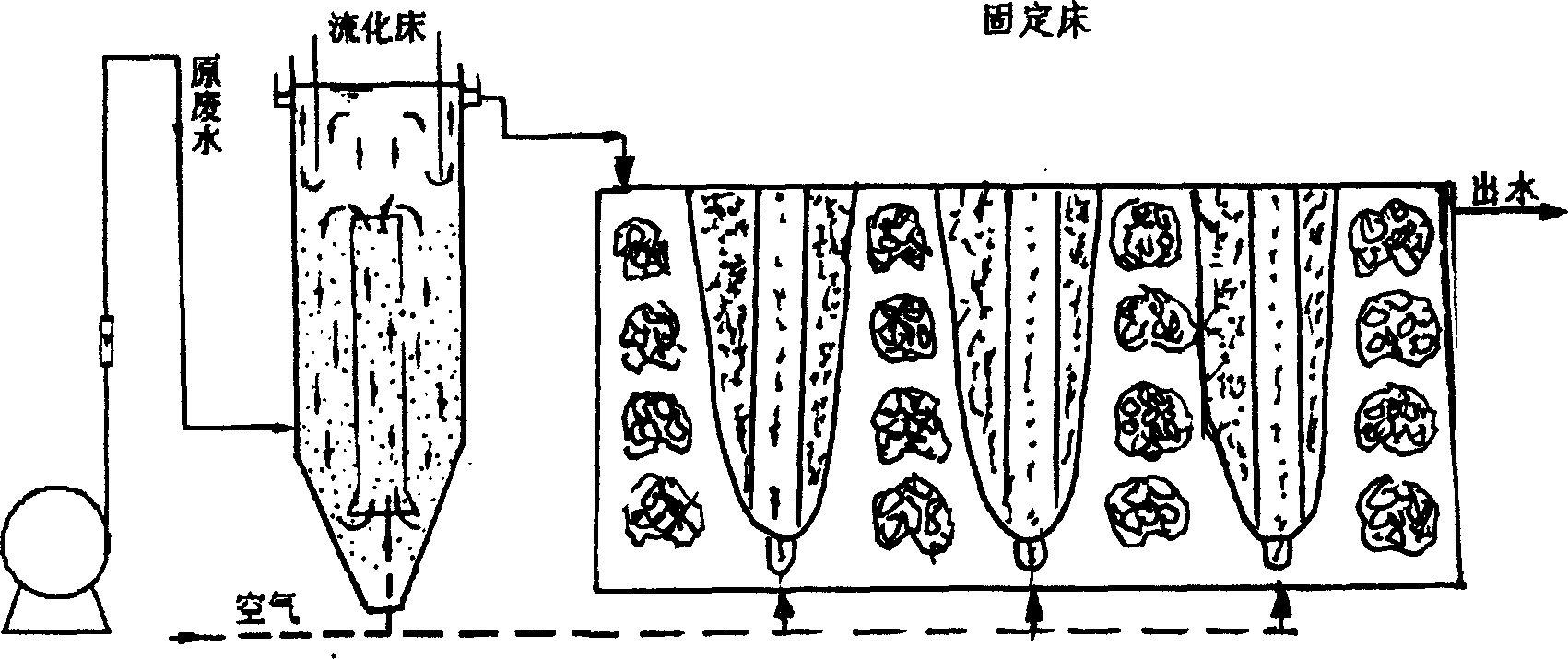Process for treating waste water by aerobic-anaerobic microbic repeated coupling
An anaerobic microorganism and new process technology, which is applied in the new process field of aerobic-anaerobic microbial repeated coupling treatment of sewage, can solve the problems of device blockage, biofilm easy to fall off, weak denitrification function, etc., achieve efficient removal and save foundation The effect of construction and operating costs
- Summary
- Abstract
- Description
- Claims
- Application Information
AI Technical Summary
Problems solved by technology
Method used
Image
Examples
Embodiment 1
[0017] Experimental conditions:
[0018]
[0019] When the residence time of the fluidized bed is 2h and the residence time of the fixed bed is 11h, for the COD of the influent Gr In 500-600mg / L, ammonia nitrogen 20-25mg / L synthetic wastewater, after 160 days of continuous operation, the removal of organic matter can reach 85-99%, the removal of ammonia nitrogen can reach 35%, and the removal of total nitrogen It can reach 20% to 30%. COD of effluent Gr <60mg / L, suspended solids (SS) in effluent <20mg / L, pH between 7-8. The COD, ammonia nitrogen, SS and pH in the treated water all meet the national first-level discharge standards.
Embodiment 2
[0021] Experimental conditions:
[0022]
[0023] When the residence time of the fluidized bed is increased to 4h and the residence time of the fixed bed is still 11h, the COD of the influent Gr In 500-600mg / L, ammonia nitrogen is 20-25mg / L synthetic wastewater, after 110 days of continuous operation, it shows that the removal efficiency of organic matter is 85-99%, and the removal efficiency of ammonia nitrogen can reach 40-50%. Nitrogen removal can reach about 45%. COD of effluent Gr <40mg / L, effluent suspended solids (SS) <20mg / L, pH between 7-8. The COD, ammonia nitrogen, SS and pH in the treated water all meet the national first-level discharge standards.
Embodiment 3
[0025] Experimental conditions:
[0026]
[0027] Controlling the residence time, the inlet concentration of COD and ammonia nitrogen is the same as in Example 2, except that the liquid at the outlet of the fixed bed is returned to the inlet of the fixed bed with a constant flow pump. The main purpose is to increase the residence time and the distance of the wastewater in the reactor. The effect of the fixed bed flow-down distance on the treatment effect. After 30 days of continuous operation, it shows that the removal efficiency of organic matter has declined, but it is also higher than 70%. The main reason is that the reflux increases the horizontal movement of microorganisms in the fixed bed, and the dead microorganisms also increase; the removal efficiency of ammonia nitrogen is reduced. The improvement can reach 40-70%, the removal of total nitrogen can reach 50%-70%, and the COD of effluent Gr Between 110-120mg / L, suspended solids (SS) in effluent water between 20-60...
PUM
 Login to View More
Login to View More Abstract
Description
Claims
Application Information
 Login to View More
Login to View More - R&D
- Intellectual Property
- Life Sciences
- Materials
- Tech Scout
- Unparalleled Data Quality
- Higher Quality Content
- 60% Fewer Hallucinations
Browse by: Latest US Patents, China's latest patents, Technical Efficacy Thesaurus, Application Domain, Technology Topic, Popular Technical Reports.
© 2025 PatSnap. All rights reserved.Legal|Privacy policy|Modern Slavery Act Transparency Statement|Sitemap|About US| Contact US: help@patsnap.com



